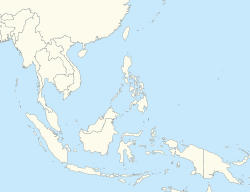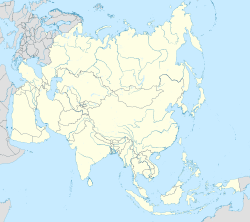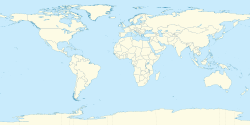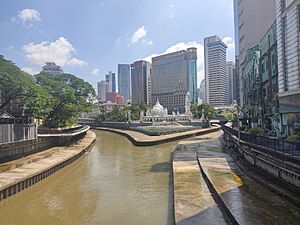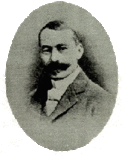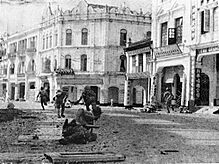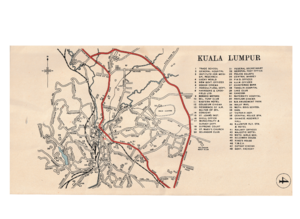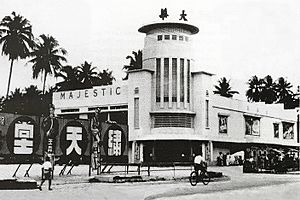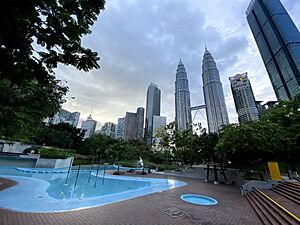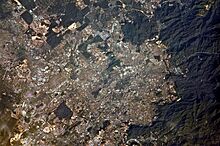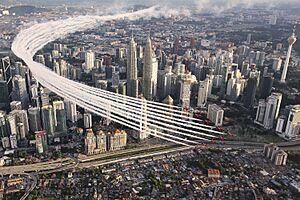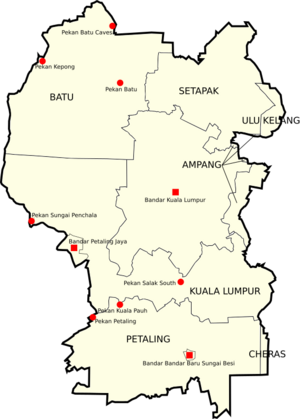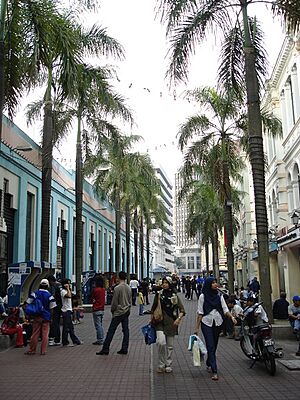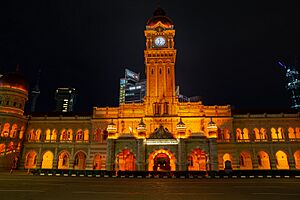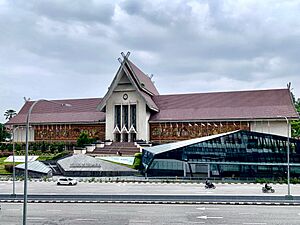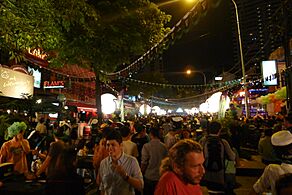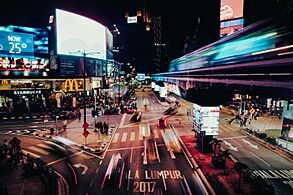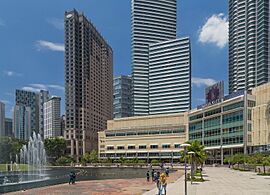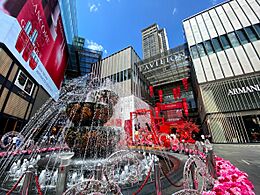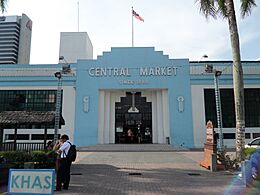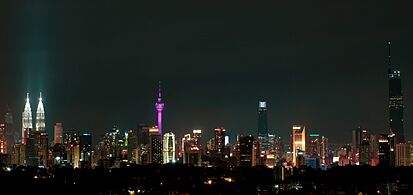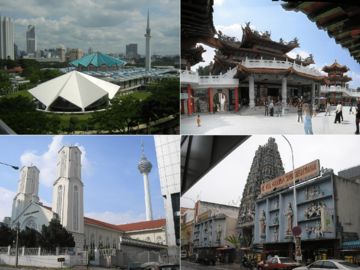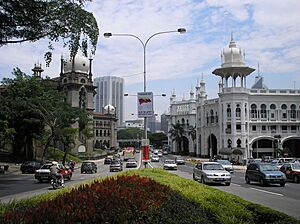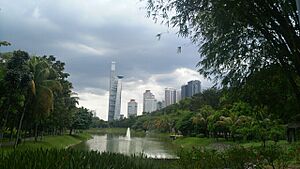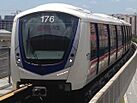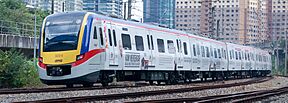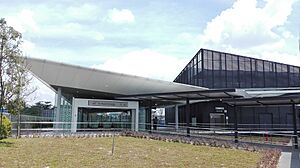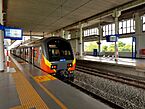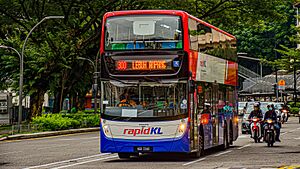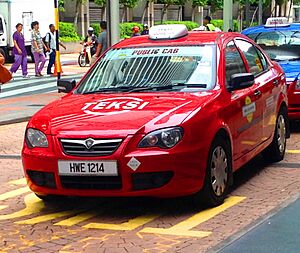Kuala Lumpur facts for kids
Quick facts for kids
Kuala Lumpur
|
|||
|---|---|---|---|
|
Federal capital city and federal territory
|
|||
| Federal Territory of Kuala Lumpur Wilayah Persekutuan Kuala Lumpur |
|||
| Other transcription(s) | |||
| • Jawi | ولايه ڤرسکوتوان کوالا لومڤور | ||
| • Chinese | 吉隆坡联邦直辖区 (Simplified) 吉隆坡聯邦直轄區 (Traditional) Jílóngpō liánbāng zhí xiáqū (Hanyu Pinyin) gat1 lung4 bo1 (Cantonese) (Jyutping) gāt lùhng bō (Yale Romanisation) |
||
| • Tamil | கோலாலம்பூர் கூட்டரசு பகுதி Kōlālampūr kūṭṭaracu pakuti (Transliteration) கோலாலம்பூர் Kōlā lampūr (Transliteration) |
||
|
Skyline of CBD at night
Merdeka Square
National Mosque
Bukit Bintang
Petaling Street
National Palace
National Monument
|
|||
|
|||
| Nickname(s):
KL , New York of Southeast Asia
|
|||
| Motto(s):
Bersedia Menyumbang Bandaraya Cemerlang
English: Ready to Contribute towards an Excellent City |
|||
| Anthem: Maju dan Sejahtera English: Progress and Prosper |
|||
 |
|||
| Country | |||
| Administrative areas |
List
|
||
| Establishment | 1857 | ||
| City status | 1 February 1972 | ||
| Transferred to federal jurisdiction | 1 February 1974 | ||
| Government | |||
| • Type | Federal administration with local government |
||
| • Body | Kuala Lumpur City Hall | ||
| Area | |||
| • Federal capital city and federal territory | 243 km2 (94 sq mi) | ||
| • Metro | 2,243.27 km2 (866.13 sq mi) | ||
| Elevation | 63 m (207 ft) | ||
| Highest elevation
(Bukit Dinding)
|
302 m (991 ft) | ||
| Population
(Q1 2024)
|
|||
| • Federal capital city and federal territory | 2,075,600 | ||
| • Rank | 1st | ||
| • Density | 8,542/km2 (22,120/sq mi) | ||
| • Urban | 8,430,775 | ||
| • Metro | 8,815,630 | ||
| • Metro density | 2,708/km2 (7,010/sq mi) | ||
| • Demonym | KLite / KL-ite / Kuala Lumpurian | ||
| City Index | |||
| • HDI (2022) | 0.886 (very high) (1st) | ||
| • GDP (2023) | RM 277.519 billion (US$60.387 billion) (2nd) | ||
| • Per capita (2023) | RM 131,038 ($28,520) (1st) | ||
| Time zone | UTC+8 (MST) | ||
| Postal code |
50000 to 60000
|
||
| Mean solar time | UTC+06:46:46 | ||
| Area code(s) | 03 | ||
| Vehicle registration | V and W (except taxis) HW (for taxis only) |
||
| ISO 3166-2 | MY-14 | ||
| Official language(s) | Malay | ||
Kuala Lumpur, often called KL, is the capital city of Malaysia. It is also a special area known as a federal territory. KL is the biggest city in Malaysia. It covers about 243 square kilometers and has over 2 million people as of 2024. The larger area around KL, called Greater Kuala Lumpur or the Klang Valley, has about 8.8 million people. It is one of the fastest-growing areas in Southeast Asia.
Kuala Lumpur is super important for Malaysia. It's the main place for culture, money, tourism, and politics. The country's Parliament and the official home of the King of Malaysia, the Istana Negara, are here. Kuala Lumpur started around 1857 because of tin mining. Important people like Yap Ah Loy and Frank Swettenham helped it grow a lot.
KL was the capital of Selangor state until 1978. It was also the first capital of Malaya and later Malaysia. While some government offices moved to Putrajaya in 1999, many important political parts are still in Kuala Lumpur. The city is one of three Federal Territories in Malaysia. It is surrounded by the state of Selangor on the west coast of Peninsular Malaysia.
Since the 1990s, Kuala Lumpur has hosted many big international events. These include the 1998 Commonwealth Games and Formula One races. The city has grown very fast. It is home to the Petronas Towers, which were once the world's tallest twin buildings. These towers are now a famous symbol of Malaysia's growth. Kuala Lumpur has a great public transport system. You can easily travel to nearby cities and the Kuala Lumpur International Airport (KLIA) by train.
In 2019, Kuala Lumpur was the 6th most visited city in the world. It has three of the world's ten largest shopping malls. UNESCO named Kuala Lumpur the World Book Capital in 2020. In 2024, it was ranked the second-best city in Southeast Asia for overall quality, after Singapore.
Contents
What Does Kuala Lumpur Mean?
The name Kuala Lumpur means "muddy meeting point" in Malay. Kuala means where two rivers join or an estuary. Lumpur means "mud".
Some people think it was named after a "muddy river" called Sungai Lumpur. However, Kuala Lumpur is where the Gombak River and Klang River meet. Usually, the meeting point is named after the smaller river joining the bigger one. So, it should be Kuala Gombak.
Another idea is that it was first called Pengkalan Lumpur, meaning "muddy landing place." This name might have changed over time to Kuala Lumpur. There are no old records to fully prove these ideas.
History of Kuala Lumpur
![]() Sultanate of Selangor 1857–1974
Sultanate of Selangor 1857–1974
![]() Federated Malay States 1895–1942; 1945–1946
Federated Malay States 1895–1942; 1945–1946
![]() Empire of Japan 1942–1945
Empire of Japan 1942–1945
![]() Malayan Union 1946–1948
Malayan Union 1946–1948
![]() Federation of Malaya 1948–1963
Federation of Malaya 1948–1963
![]() Malaysia 1963–present
Malaysia 1963–present
How Kuala Lumpur Began
Kuala Lumpur started as a small village. It had only a few houses and shops. It was located where the Sungai Gombak and Klang River meet. In 1857, Raja Abdullah, a Malay chief, sent Chinese miners to find tin here. These miners landed at Kuala Lumpur and walked to Ampang to open the first mine.
Kuala Lumpur became an important spot. Supplies for the tin mines could easily be brought here by boat. Even though many miners died from malaria, the Ampang mines were successful. They exported the first tin in 1859.
Two traders, Hiu Siew and Yap Ah Sze, set up shops. They sold food to miners and bought tin. The town grew around Old Market Square. Roads were built to connect it to other mining areas like Ampang and Pudu. Miners often formed gangs and fought over tin mines. Chinese community leaders were called Kapitan Cina. Hiu Siew was the first Kapitan. Yap Ah Loy became the third Kapitan in 1868.
Important Malay leaders also helped the town grow. Haji Mohamed Tahir was a chief of traders. People from Sumatra, like the Minangkabaus, also came to trade. They started tobacco farms. Haji Mohamed Taib was important in developing Kampung Baru.
The Start of Modern Kuala Lumpur
Early Kuala Lumpur faced many problems. Buildings were made of wood and palm fronds, so they often caught fire. There was also poor sanitation, leading to diseases. Flooding was a constant threat because of its location.
The town was part of the Selangor Civil War. This war was partly about who controlled the tin mines. Yap Ah Loy fought against a rival group. Kuala Lumpur was captured and burned down in 1872. Yap Ah Loy escaped, gathered more fighters, and took back the city in 1873.
After the war, tin prices dropped, and a cholera outbreak made many people leave. The town struggled until tin prices went up again in 1879. In 1881, a big fire destroyed the whole town, followed by severe flooding. But the town was rebuilt again and again, thanks to Yap Ah Loy.
Frank Swettenham became the British Resident in 1882. He and Yap Ah Loy were key figures in Kuala Lumpur's early growth. Swettenham helped the city grow fast and become a major urban center.

In 1880, Kuala Lumpur became the capital of Selangor. British government buildings were built west of the river. The Padang (now Merdeka Square) was first used for police training. Later, it became the center for British offices.
Swettenham made rules that buildings had to be made of brick and tile. This made them less likely to burn. Streets were also made wider to reduce fire risks. Yap Ah Loy even set up a brick factory in Brickfields to help rebuild the city. Many new buildings had "five-foot ways" and Chinese designs.
Yap Ah Loy also improved roads. He connected tin mines to the city. As Kapitan, he had a lot of power, similar to Malay leaders. He helped create laws and even ran a small court. He built Kuala Lumpur's first school and a tapioca factory.

A railway line from Kuala Lumpur to Klang was finished in 1886. This made the city grow even faster. The population jumped from 4,500 in 1884 to 20,000 in 1890. A Sanitary Board was created in 1890 to manage cleanliness and roads. This board later became the Kuala Lumpur City Hall. In 1896, Kuala Lumpur was chosen as the capital of the new Federated Malay States.
Kuala Lumpur in the 20th Century and Today
Kuala Lumpur grew a lot in the 20th century. Its size increased from 0.65 square kilometers in 1895 to 243 square kilometers by 1974. The rubber industry boomed in the early 1900s. This caused Kuala Lumpur's population to grow from 30,000 in 1900 to 80,000 in 1920. Chinese businessmen like Loke Yew played a big role in the city's economy.
During World War II, the Imperial Japanese Army captured Kuala Lumpur on January 11, 1942. Many lives were lost during the occupation. Thousands of Chinese people were killed. Many Indians were forced to work on the Burma Railway, where many died. The Japanese occupied the city until August 15, 1945.
The first city election in Kuala Lumpur was held in 1952. On August 31, 1957, Malaya became independent from British rule. The Malayan flag was raised for the first time at the Padang. The ceremony for independence was held at the Merdeka Stadium. Kuala Lumpur remained the capital when Malaysia was formed in 1963. The Malaysian Houses of Parliament were finished in 1963.
Kuala Lumpur has seen some difficult times. In 1969, there were serious race riots. This event, called the 13 May Incident, led to changes in the country's economic policy. The goal was to help Malays participate more in business.
City and Federal Territory Status

Kuala Lumpur became a city on February 1, 1972. It was the first place in Malaysia to get city status after independence. Then, on February 1, 1974, Kuala Lumpur became a federal territory. This meant it was directly controlled by the national government. It stopped being the capital of Selangor in 1978. Shah Alam became the new state capital.
On May 14, 1990, Kuala Lumpur celebrated 100 years of its local council. A new Kuala Lumpur flag and anthem were introduced. In 2001, Putrajaya became a Federal Territory and the new seat of the federal government. Many government offices moved there. However, Kuala Lumpur still has the legislative function and is home to the King.
Since the 1990s, the area around Kuala Lumpur has grown a lot. This area is known as Greater Kuala Lumpur. It includes other towns like Klang and Shah Alam. New projects in Kuala Lumpur include the Kuala Lumpur City Centre (KLCC). This area has the Petronas Towers, which were once the world's tallest buildings. Now, The Exchange 106 and Merdeka 118 are even taller. Merdeka 118 is the second tallest building in the world.
Geography of Kuala Lumpur
Kuala Lumpur is in a large area called the Klang Valley. This valley is surrounded by the Titiwangsa Mountains to the east. There are also smaller mountain ranges to the north and south. The Strait of Malacca is to the west. Kuala Lumpur is located where the Klang and Gombak rivers meet.
Kuala Lumpur is in the middle of Selangor state. In 1974, it became a special Federal Territory. This means it is managed directly by the Malaysian government. Its location in a developed area with flat land helped it grow quickly. The city covers about 243 square kilometers. Its highest point is Bukit Nanas, which is 94 meters above sea level.
Kuala Lumpur's Climate
| Weather chart for Kuala Lumpur | |||||||||||||||||||||||||||||||||||||||||||||||
|---|---|---|---|---|---|---|---|---|---|---|---|---|---|---|---|---|---|---|---|---|---|---|---|---|---|---|---|---|---|---|---|---|---|---|---|---|---|---|---|---|---|---|---|---|---|---|---|
| J | F | M | A | M | J | J | A | S | O | N | D | ||||||||||||||||||||||||||||||||||||
|
227
33
24
|
193
33
24
|
270
34
25
|
302
34
25
|
230
34
25
|
146
33
25
|
165
33
24
|
174
33
25
|
220
33
24
|
284
33
24
|
356
32
24
|
281
32
24
|
||||||||||||||||||||||||||||||||||||
| temperatures in °C precipitation totals in mm |
|||||||||||||||||||||||||||||||||||||||||||||||
|
Imperial conversion
|
|||||||||||||||||||||||||||||||||||||||||||||||
Kuala Lumpur has a tropical rainforest climate. It is hot, humid, and sunny all year. There is a lot of rain, especially from October to March. Temperatures usually stay between 32 and 35 degrees Celsius. They rarely drop below 23 degrees Celsius.
The city gets at least 2600 mm of rain every year. Even in drier months, it still rains a lot. Kuala Lumpur often has strong thunderstorms and lightning. The Klang Valley is one of the places on Earth with the most thunderstorms.
Heavy rain can cause floods in Kuala Lumpur. This is especially true in the city center. Smoke from forest fires in nearby Sumatra and Kalimantan can also cause haze. This haze is a big source of pollution.
How Kuala Lumpur is Governed
Kuala Lumpur was managed by a special commissioner until 1972. Then, it became a city, and a Lord Mayor was appointed. Since then, 14 mayors have been in charge. The current mayor is Kamarulzaman Mat Salleh.
Kuala Lumpur's Districts
Kuala Lumpur is divided into eleven areas for its parliamentary representatives. These areas are also administrative parts of the city. They are managed by the Kuala Lumpur City Hall.
|
|
|
||||||||||||||||||||||||||||||||||||||||||||||||||||||||||||||||||||
Mukims: Smaller Divisions
For managing land, Kuala Lumpur is split into eight smaller areas called mukims. It also has several towns. These mukims include:
- Bandar Kuala Lumpur
- Mukim Kuala Lumpur (Suburban district)
- Mukim Petaling
- Mukim Batu
- Mukim Setapak
- Mukim Ampang
- Mukim Ulu Kelang
- Mukim Cheras (Alam Damai)
Kuala Lumpur's Economy
Kuala Lumpur and its nearby areas are the most industrial and fastest-growing parts of Malaysia. Even though the government moved some offices to Putrajaya, many important places stayed in KL. These include the National Bank of Malaysia and most embassies. Kuala Lumpur is still the main place for business and money in the country. It is a center for finance, insurance, real estate, media, and arts.

The Bursa Malaysia, which is Malaysia's stock exchange, is in the city. This is a key part of its economy. In 2008, Kuala Lumpur's economy was worth about RM73.5 billion. By 2015, it grew to RM160.3 billion. The average income per person in KL was RM94,722 in 2015.
Most jobs in Kuala Lumpur are in the service sector. This includes finance, insurance, real estate, and tourism. About 83% of jobs are in these areas. The other 17% are in manufacturing and construction.
Many local and foreign banks are in the city. Kuala Lumpur is also becoming a global center for Islamic finance. Many international companies have offices here. Most of Malaysia's biggest companies have their main offices in Kuala Lumpur.
The city is also focusing on research and development. These activities help support Malaysia's economy. Kuala Lumpur has important research centers like the Rubber Research Institute. A new financial area called the Tun Razak Exchange (TRX) is being built. Its main building is The Exchange 106 tower. This new hub will bring more international business to Kuala Lumpur. It is part of Malaysia's plan to become a high-income country.
Tourism in Kuala Lumpur
Tourism is a very important part of Kuala Lumpur's economy. Many big hotel chains have hotels in the city. Kuala Lumpur is the sixth most visited city in the world. It gets 8.9 million tourists every year. People love visiting because of its diverse culture, affordable prices, and great food and shopping.
Conventions and exhibitions are also growing. This will help the industry even more. There are also many affordable hotels in the city.
Some of the most popular places to visit in Kuala Lumpur are:
- The Petronas Towers
- The Bukit Bintang shopping area
- The Kuala Lumpur Tower
- Petaling Street (Chinatown)
- Merdeka Square
- The National Mosque of Malaysia
- The Islamic Arts Museum
- The Kuala Lumpur Bird Park, which is the world's largest aviary.
Kuala Lumpur hosts many cultural events. One is the Thaipusam procession at the Sri Mahamariamman Temple. The Kuala Lumpur Fashion Week is also held here every year.
Shopping in Kuala Lumpur
Kuala Lumpur has 66 shopping malls. It is a major retail and fashion center in Malaysia and Southeast Asia. Shopping brings in a lot of money from tourism.
Suria KLCC is a top shopping spot. It is located right under the Petronas Twin Towers. The Bukit Bintang area has the most shopping malls. These include Pavilion KL, Berjaya Times Square, and Lot 10. The Changkat area in Bukit Bintang has many cafes and outdoor restaurants.
Other shopping areas include Bangsar and Mid Valley Megamall. Kuala Lumpur also has special zones for local products. You can find Malaysian textiles, crafts, and traditional clothes like baju Kurung and baju kebaya. Petaling Street, or Chinatown, has many old buildings and unique shops.
Since 2000, the Malaysian Ministry of Tourism has held mega sale events. These sales happen three times a year to make Kuala Lumpur a top shopping destination in Asia.
- Gallery
-
Suria KLCC, located between the Petronas Twin Towers.
-
The Carigali Tower, Petronas Twin Towers, Maxis Tower and Four Seasons Place KL from left.
People of Kuala Lumpur
| Ethnicities of Kuala Lumpur – 2020 Census | ||||
|---|---|---|---|---|
| Ethnic group | Percent | |||
| Bumiputras | 47.7% | |||
| Chinese | 41.6% | |||
| Indians | 10.0% | |||
| Others | 0.7% | |||
| Population by percentage excluding non-citizens which form 10.5% of KL's population |
||||
Kuala Lumpur is the most populated city in Malaysia. It has about 2.076 million people as of 2024. The city is very dense, with many people living close together. People who live in Kuala Lumpur are sometimes called KLites. The larger Kuala Lumpur area, the Klang Valley, has about 7.25 million people.
Kuala Lumpur has many different groups of people. The three main ethnic groups are the Malays, the Chinese, and the Indians. There are also Eurasians, Kadazans, Ibans, and other native groups from Malaysia.
Historical Population Changes
| Historical population | ||
|---|---|---|
| Year | Pop. | ±% |
| 1890 | 20,000 | — |
| 1900 | 30,000 | +50.0% |
| 1931 | 111,418 | +271.4% |
| 1957 | 316,537 | +184.1% |
| 1970 | 451,201 | +42.5% |
| 1974 | 612,004 | +35.6% |
| 1980 | 919,610 | +50.3% |
| 1991 | 1,145,342 | +24.5% |
| 2000 | 1,305,792 | +14.0% |
| 2010 | 1,588,750 | +21.7% |
| 2020 | 1,982,112 | +24.8% |
| Kuala Lumpur expanded as a Federal Territory in 1974 Source: |
||
In the past, Kuala Lumpur was mostly a Chinese city. But now, the number of Bumiputera people has grown a lot. They are now the largest group. In 1872, Kuala Lumpur was described as a "purely Chinese village." By 1875, there were about 1,000 Chinese and 700 Malays.
The population grew quickly after a railway line was built in 1886. In 1891, about 79% of the people were Chinese. The rubber industry boom in the early 1900s also brought more people. The population grew from 30,000 in 1900 to 80,000 in 1920.
After Malaysia became independent, more Malays moved to Kuala Lumpur. This was partly due to government jobs. Also, the city expanded and included rural areas where many Malays lived. By 1980, Kuala Lumpur had over a million people. About 52% were Chinese, 33% Malay, and 15% Indian.
By 2010, the Malay population had grown to 44.7%. The Chinese population was 43.2%. In the 2020 census, Bumiputera people made up about 47.7% of the population. Chinese people were 41.6%, and Indians were 10.0%.
More foreign residents have moved to Kuala Lumpur recently. They made up about 10.5% of the population in 2020. Many foreign workers come from countries like Indonesia, Nepal, and Bangladesh.
The number of young people in Kuala Lumpur has gone down. In 1980, 33% of the people were under 15. In 2000, it was less than 27%. The number of working-age people (15–59) increased. The number of elderly people (60 and above) also increased.
Languages and Religions in Kuala Lumpur
| Religion in Kuala Lumpur – 2020 Census | ||||
|---|---|---|---|---|
| Religion | Percent | |||
| Islam | 45.3% | |||
| Buddhism | 32.3% | |||
| Hinduism | 8.2% | |||
| Christianity | 6.4% | |||
| Others | 1.8% | |||
| No Religion | 6.0% | |||
Kuala Lumpur has many different religions and cultures. There are many places of worship for everyone. Islam is mainly practiced by Malays and Indian Muslims. Buddhism, Confucianism, and Taoism are mostly practiced by Chinese people. Indians usually follow Hinduism. Some Chinese and Indians are also Christians.
In the 2020 Census, 45.3% of Kuala Lumpur's population was Muslim. 32.3% were Buddhist, 8.2% Hindu, and 6.4% Christian. 1.8% followed other religions, and 6.0% had no religion.
The main language in Kuala Lumpur is Bahasa Malaysia. Most local Malays speak the Selangor dialect. People in Kuala Lumpur generally know English well. Many use it as their first language. English is important in business and is taught in schools.
Cantonese, Hokkien, and Mandarin are widely spoken by the Chinese population. Another Chinese dialect is Hakka. Among Indians, Tamil is the main language. Other Indian languages like Telugu and Malayalam are also spoken. People of Indonesian descent speak languages like Minangkabau and Javanese. You can also hear Arabic, Iban, and Kadazandusun in the city.
Kuala Lumpur's Cityscape
Architecture in Kuala Lumpur
Kuala Lumpur's buildings show a mix of old colonial styles, Asian traditions, and Islamic designs. It's a newer city compared to places like Bangkok. Most of its famous old buildings were built in the late 1800s and early 1900s. These buildings use styles like Mughal, Moorish Revival, and Neo-Gothic. They were changed to fit local materials and the hot, humid climate. Arthur Benison Hubback designed many of these, including the Kuala Lumpur Railway Station and Jamek Mosque.
Before World War II, many shophouses were built. These were usually two stories, with shops downstairs and homes upstairs. They mixed Chinese and European styles. Some have been replaced, but many still stand in areas like Medan Pasar Besar and Chinatown.
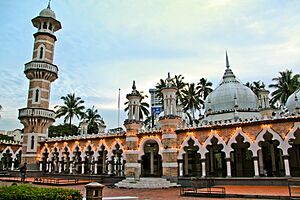
After Malaysia became independent, new buildings started to show more local and Islamic designs. Many designs came from traditional Malay items like the songkok (a cap) and the keris (a dagger). Some buildings have Islamic patterns. Examples include Telekom Tower and the Islamic Centre. Some buildings, like the Islamic Arts Museum, look like places of worship but are actually for science and knowledge.
The Petronas Towers are 452 meters tall. They are the tallest twin buildings in the world. They were the tallest buildings in Malaysia until The Exchange 106 and Merdeka 118 surpassed them. Merdeka 118 is the second tallest building in the world.
Newer, modern buildings with glass exteriors appeared in the late 1990s. The city's main business area moved to Kuala Lumpur City Centre (KLCC). Here, many new, tall buildings fill the skyline. Kuala Lumpur is ranked 10th among cities with the most buildings over 100 meters tall.
Parks and Green Spaces
Kuala Lumpur has many parks and gardens for fun and relaxation. The Perdana Botanical Garden, also called Lake Gardens, is a large botanical garden. It was the first park built in Kuala Lumpur. The Malaysian Parliament building is nearby.
Other parks in the city include:
- KLCC Park
- Titiwangsa Lake Gardens
- Metropolitan Lake Gardens in Kepong
- Taman Tasik Permaisuri (Queen's Lake Gardens)
- Bukit Kiara Botanical Gardens
There are also three forest reserves in the city. Bukit Nanas Forest Reserve is in the city center. It is one of the oldest natural forests in the world found within a city. These forest areas are home to animals like monkeys, squirrels, and birds.
Education in Kuala Lumpur
Kuala Lumpur has a very high literacy rate of 97.5%. This is the highest in Malaysia. In Malaysia, most subjects are taught in Malay. English is a required subject. Some schools also teach in Mandarin and Tamil.
Kuala Lumpur has 14 universities, 79 high schools, 155 elementary schools, and 136 kindergartens.
The University of Malaya (UM) is in Kuala Lumpur. It was started in 1949 and is the oldest university in Malaysia. It is ranked as the best university in Malaysia. Many international students now study there.
Other universities in Kuala Lumpur include:
- Universiti Tunku Abdul Rahman (UTAR)
- International Islamic University Malaysia (IIUM)
- UCSI University (UCSI)
- International Medical University (IMU)
- Open University Malaysia (OUM)
The National Defence University of Malaysia is in Kuala Lumpur. It focuses on military and defense studies. The larger Kuala Lumpur area also has international university branches. These include Monash University Malaysia Campus and University of Nottingham Malaysia Campus.
Culture in Kuala Lumpur
Arts and Entertainment
Kuala Lumpur is a center for cultural activities in Malaysia. The National Museum has many old items and paintings from across the country. The Islamic Arts Museum has over seven thousand Islamic artifacts. It is the largest collection of Islamic art in Southeast Asia.
Kuala Lumpur also has a craft complex and museum. It shows how textiles, ceramics, and metal crafts are made. You can see how pottery is made and how songket cloth is woven.
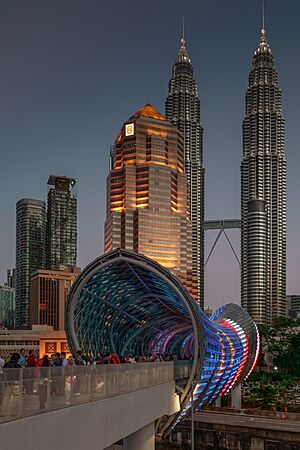
The main place for performing arts is the Petronas Philharmonic Hall. It is under the Petronas Towers. The Malaysian Philharmonic Orchestra plays here. The Kuala Lumpur Performing Arts Centre (KLPac) is another important place. It hosts plays, music, and films.
The National Art Gallery of Malaysia shows works by local and foreign artists. Kuala Lumpur also hosts the Malaysia International Gourmet Festival every year. The Kuala Lumpur Fashion Week features both international and local designers. In 2020, UNESCO named Kuala Lumpur the World Book Capital.
Sports and Fun Activities
Kuala Lumpur has many parks and open spaces for fun. The amount of land for recreation and sports has grown a lot.
Kuala Lumpur used to host the Formula One World Championship races. These races brought many tourists and a lot of money to the city. The Motorcycle Grand Prix races are held nearby in Sepang. In 2015, the Kuala Lumpur Street Circuit was built for a new motor racing event.
Football is very popular in Kuala Lumpur. The Merdeka Tournament is often held at Stadium Merdeka. The city is home to the Kuala Lumpur City football team. They play in the Malaysia Super League.
Kuala Lumpur also hosted the official Asian Basketball Championship several times. The city is home to the Kuala Lumpur Dragons basketball team. They were champions of the ASEAN Basketball League in 2016.
Other annual sports events include the KL Tower Run and the Kuala Lumpur International Marathon. Kuala Lumpur is also part of the Tour de Langkawi cycling race. The annual Malaysia Open badminton tournament is held here.
Kuala Lumpur is where "Hashing" began in 1938. This is a fun running activity started by British officers.
Transportation in Kuala Lumpur
Most people in Kuala Lumpur drive cars to get around. The city has a big road network. Public transportation includes buses, trains, and taxis. Even with efforts to promote public transport, not many people use it. However, this is changing as the train network grows.
The public transport system is run by Prasarana Malaysia. They use the Rapid KL brand name. They have changed the bus network to connect more areas. KL Sentral is the main transport hub. It was opened in 2001.
Urban Rail System
The KTM Komuter train service started in 1995. It was the first local train system in Kuala Lumpur. It connects the city to nearby suburban areas. The network has 53 stations and two main routes.
The Light Rapid Transit (LRT) system has three lines. The first LRT line opened in 1996. The government is expanding the Sri Petaling Line and Kelana Jaya Line.
The Mass Rapid Transit (MRT) is a heavy rail system. It is a big part of Kuala Lumpur's railway network. The first MRT section opened in 2016. The network has three lines planned. These lines will connect high-density areas that don't have train service yet. About 90 new stations are planned. Some will be underground in the city center.
The KL Monorail opened in 2003. It has 11 stations and runs on elevated tracks. It connects the KL Sentral transport hub to the "Golden Triangle" area. This area is known for shopping and entertainment.
Kuala Lumpur has two airports. The main one is Kuala Lumpur International Airport (KLIA). It is about 50 km south of the city. KLIA is Malaysia's main aviation hub. You can reach KLIA using the KLIA Ekspres train from KL Sentral. This trip takes 28 minutes. Buses are also available and cost less.
The other airport is Sultan Abdul Aziz Shah Airport. It is now used for smaller, propeller-driven flights.
Buses in Kuala Lumpur
The Bas Mini KL (Kuala Lumpur Mini-Bus Service) used to be a popular public bus service. These small, pink buses served Kuala Lumpur until 1998. They were replaced by other bus services.
Rapid Bus started changing its bus network in 2006. They added City Shuttle routes in the city center. By 2008, Rapid Bus had 1,400 buses on 167 routes. They served about 400,000 passengers daily. The buses run between four main hubs. These hubs are also connected to train stations.
Since 2019, all RapidKL buses are cashless. You can only use Touch 'n Go cards. Rapid Bus also provides real-time bus locations on Google Maps. Other bus companies also operate in Kuala Lumpur.
Taxis in Kuala Lumpur
Most taxis in Kuala Lumpur are white and red. Many companies have their own cars. In the past, cars like Mercedes-Benz and Mazda were used. Now, most taxis are Protons. Kuala Lumpur is one of the cities where many taxis run on natural gas.
You can find taxis at special stands or on the streets. However, more people are now using ride-sharing services like Grab. This has led to fewer people using traditional taxis.
Twin Towns and Sister Cities
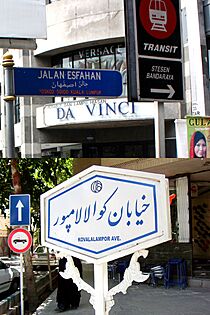
Kuala Lumpur has special connections with other cities around the world. These are called twin towns or sister cities:
- Ankara, Turkey
- Casablanca, Morocco
- Chennai, India
- Dubai, United Arab Emirates
- Isfahan, Iran
- Karachi, Pakistan
- London, United Kingdom
- Malacca City, Malaysia
- Mashhad, Iran
See also
 In Spanish: Kuala Lumpur para niños
In Spanish: Kuala Lumpur para niños












